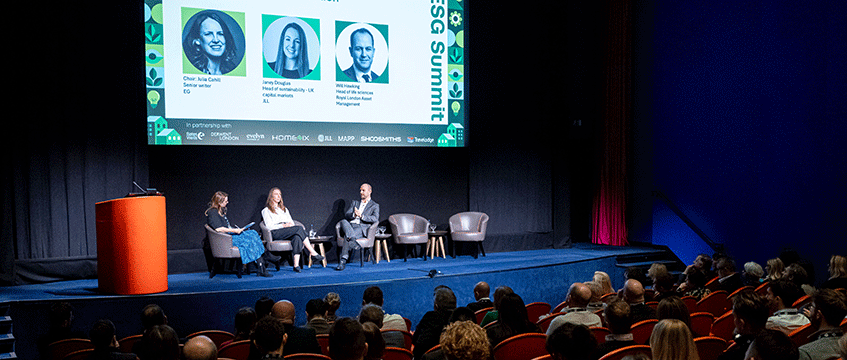Sustainability is impacting transactions every day. And that impact is only ramping up as the market recovers. In fact, 70% of investors told JLL’s investor survey this summer that sustainability had either influenced their decision to buy or bid on an asset or influenced their pricing in some way.
This was the starting point for a candid discussion at EG’s ESG Summit about how sustainability is impacting deals in the market and the challenges it presents. Janey Douglas, head of sustainability in the UK capital markets team at JLL, gave her insight as an investment adviser, while Will Hawking, head of life sciences at Royal London Asset Management, brought the investor perspective.
Douglas said the return of core capital to the market meant increasingly sophisticated questions were being asked about sustainability, driven by compliance and transition risk.
“We track sustainability deal impacts in our team and the frequency of those deal impacts is majority-led by core, institutional investment manager-types who have got quite established sustainability protocols in place,” she said.
“We’re seeing EPC operating reports coming up on deals frequently. There is also a massive focus on that all-important net zero carbon alignment, so net zero carbon audits are frequently coming up at acquisition stage too,” she said.
Douglas cited a recent example in which JLL advised a core investor on the acquisition of an industrial estate. “They needed a net-zero pathway to get their investment committee approval. That is typical,” she said.
Occupier engagement
With the net zero transition in mind, this group of investors is also keenly focused on occupier engagement. “They need to understand whether they’ve got a collaborative tenant,” said Douglas.
“Have they got a tenant that might compromise their own net zero goals? Is that business going to survive a transition? We’ve seen some sensitivity to that.”
She recalled several European core investors walking away from a retail park investment which included an indoor ski slope because “they couldn’t understand the transition sufficiently”. “So that impacted liquidity,” she said.
RLAM – part of the UK’s largest mutual life, pensions and investment company – is a core investor but, as a leading UK institution, is also looking at value add and development opportunities. Its property arm manages around £10bn invested in UK real estate and Hawking said the biggest driver for how it operates is its stated goal to “do the right thing for future generations”.
What this means in practice is that its traditional acquisition checklist – which goes through all the fundamental nuts and bolts of a building, its location, its sector – is overlayed with a “day one sustainability plan”. This covers between 30 to 40 metrics ranging from the “prefer to have” through to decision-critical.
“We then have a 100-day plan, which looks to wrap up a lot of the stuff that won’t necessarily be available on day one of the acquisition,” he said. Transport and utilities are particularly challenging areas, he added. Another is insurance. “Trying to get policies underwritten for what would historically have been relatively straightforward issues like flood risk is a real challenge. I don’t think the insurance market has evolved sufficiently to really understand what those risks look like and what the costs associated with them should be.”
For RLAM, the asset can be added to its block policy covering more than 250 buildings and a premium paid for that additional risk. The problem comes when it wants to exit individual assets. “If the likely buyers are high-net-worth individuals, for example, they may or may not be able to get insurance, and that could affect liquidity and ultimately pricing,” he said. It’s a point which illustrates the far-ranging impact of sustainability on different facets of the market.
Managing expectations
Elsewhere on the spectrum of investors, Douglas said she is also seeing sustainability impact more opportunistic, private equity investors. “They still have an eye on compliance – that’s very important to them. But with shorter-term business plan horizons they might be more focused on occupier expectations and on what their exit looks like,” she explained. That could mean dealing with some hurdles early on – but they may not go to the same level or extent of diligence that core investors would.
She cited a recent example, acting buy-side for an investor on an office asset where there was the opportunity to electrify the building, but the vendor had already purchased new gas-fuelled equipment. The would-be investor factored the costs of electrification into its bid, but the vendor’s price expectations for the sale were quite different. “There wasn’t a meet-in-the-middle to allow the deal to progress,” she said.
Driving return
Speaking from a longer-term, institutional perspective, Hawking stressed that viability remains key to investment strategy. “While ESG is fundamental to everything we do, we are there to drive a return for our customers,” he said. That means for every pound spent or invested on buying and repositioning an asset to make it as green as possible, “we need to make sure we have an occupier at the back end of that”. The challenge, he said, is that occupiers are rarely involved in decision-making at an early enough stage to affect the embodied carbon discussion. “So ultimately, everything falls back to the occupational piece,” he said.
Clearly there are plenty of challenges ahead. Perhaps the key take-away was this: with a broader range of capital asking increasingly sophisticated sustainability questions, those running a disposal process need to be able to answer those queries in order to protect liquidity.
In partnership with

Image © Telling Photography
Send feedback to Julia Cahill
Follow Estates Gazette











